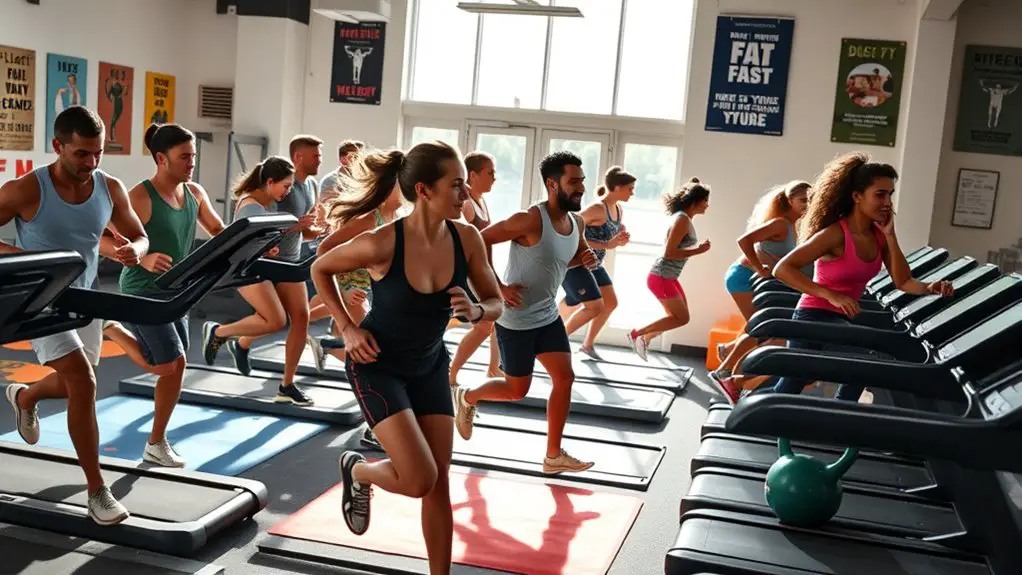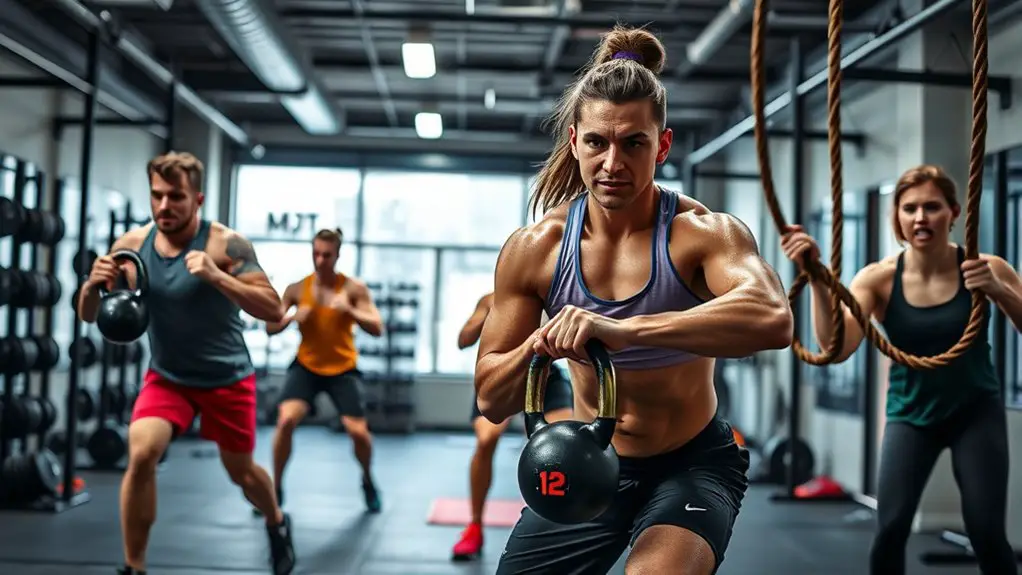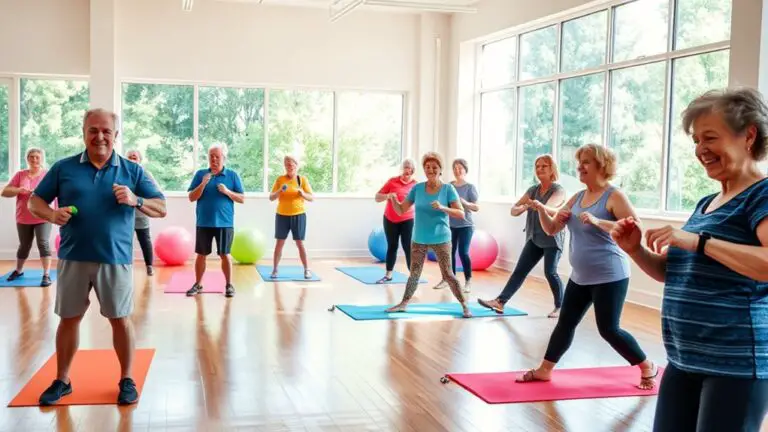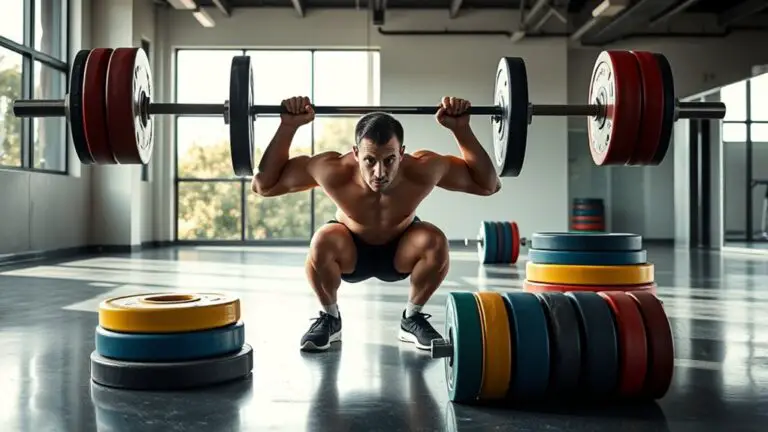Best HIIT Workouts to Burn Fat Fast

To burn fat fast with HIIT, try high-intensity exercises that increase your heart rate, like jumping jacks or burpees, for 30 seconds followed by 30 seconds of rest. Incorporate variations like Tabata or circuit training, focusing on form to prevent injuries. Aim for 3-5 sessions a week, and mix bodyweight moves with equipment for more challenge. With some simple adjustments, you can maximize your workouts and achieve your goals. Discover more effective HIIT techniques to enhance your fitness journey.
Understanding HIIT: The Science Behind the Workouts

When you plunge into the world of High-Intensity Interval Training (HIIT), you’ll quickly discover that its effectiveness isn’t just a trend—it’s rooted in science. HIIT combines short bursts of intense activity with periods of rest or lower-intensity exercise, maximizing workout efficiency. This approach triggers significant metabolic benefits, including increased calorie burn and improved cardiovascular health, even after your workout ends.
You’ll appreciate how HIIT can fit into your busy schedule, allowing you to achieve more in less time while minimizing the risk of injury through structured intervals. As you engage in these short, intense workouts, your body adapts by enhancing its ability to utilize energy efficiently. This means you’re not just burning calories during the workout; you’re also boosting your overall metabolism for hours afterward. Understanding these principles can help you make informed choices and embrace HIIT safely and effectively.
Essential HIIT Exercises for Beginners
If you’re new to HIIT, starting with the right exercises can make all the difference in your experience. Focus on foundational movements like bodyweight squats, modified push-ups, and jumping jacks. These exercises are effective and allow for beginner modifications, ensuring you can adjust the intensity to match your fitness level.
It’s essential to maintain proper form to avoid injury, so take your time and listen to your body. Many beginners make common mistakes, such as rushing through exercises or neglecting rest periods. Incorporating short intervals of work followed by adequate recovery is key to maximizing benefits without overexerting yourself. Additionally, consider incorporating exercises that target upper back muscles to enhance overall strength and posture.
Always remember to warm up before diving into your HIIT session, and consider cooling down afterward to aid recovery. By choosing the right exercises and being mindful of your limits, you’ll set a solid foundation for your HIIT journey.
Advanced HIIT Workouts for Experienced Athletes

If you’re ready to take your HIIT training to the next level, understanding high-intensity intervals is essential. You’ll also want to incorporate complex movement variations that challenge your strength and agility. Let’s explore how these elements can elevate your workouts and push your limits.
High-Intensity Intervals Explained
Understanding high-intensity intervals is essential for experienced athletes looking to push their limits and maximize performance. Proper interval timing and recovery periods are vital for safety and effectiveness. Here are key factors to take into account:
- Warm-up: Always begin with a thorough warm-up to prevent injury.
- Interval Length: Choose intervals that challenge you but are manageable; typically, 20-60 seconds of high effort works well.
- Recovery Periods: Allow adequate recovery, usually 1:1 or 2:1 ratio, to maintain intensity.
- Cool-down: Don’t skip the cool-down; it helps your body shift back to rest.
Complex Movement Variations
While many HIIT workouts focus on basic movements, incorporating complex movement variations can take your training to the next level. These dynamic exercises challenge your body in new ways, improving strength, coordination, and overall athleticism. Think about integrating movements like kettlebell swings, burpee to box jumps, or single-leg deadlifts, which combine multiple muscle groups and engage your core.
When performing these advanced moves, prioritize form over speed to guarantee safety and prevent injury. Functional training is key here; it mimics real-life movements, enhancing your performance in daily activities. As you progress, keep your workouts varied and listen to your body, allowing for adequate recovery. This approach will help you burn fat effectively while building a strong, resilient physique.
Bodyweight HIIT: No Equipment Needed
Bodyweight HIIT workouts are a fantastic way to get fit without the need for any equipment, making them perfect for anyone looking to squeeze in a quick yet effective session anywhere. These workouts offer numerous bodyweight benefits, like improving flexibility and strength while allowing you to control workout intensity.
Bodyweight HIIT workouts provide an effective, equipment-free way to enhance fitness, flexibility, and strength anytime, anywhere.
When doing bodyweight HIIT, keep these safety tips in mind:
- Warm up: Always start with a light warm-up to prevent injuries.
- Listen to your body: If something doesn’t feel right, modify or rest.
- Focus on form: Proper technique is essential for safety and effectiveness.
- Cool down: Don’t skip the cool-down to help your muscles recover.
Incorporating bodyweight HIIT into your routine can boost your fitness level and help you burn fat fast, all while keeping safety at the forefront. Enjoy the flexibility and convenience of working out anytime, anywhere!
HIIT With Equipment: Taking It up a Notch

If you’re ready to elevate your HIIT workouts, using equipment can really amp up your routine. From essential gear to sample workouts, there are plenty of ways to challenge yourself. Just remember to keep safety in mind as you push your limits!
Essential Equipment Choices
To elevate your HIIT workouts, investing in the right equipment can make all the difference. Choosing safe and effective tools enhances your routine while minimizing injury risk. Here are some essential equipment choices to reflect on:
- Dumbbell choices: Opt for adjustable dumbbells to accommodate various exercises and strength levels.
- Resistance bands: These versatile bands add intensity and can be easily modified for different movements.
- Mat: A quality exercise mat provides cushioning for floor work and stability.
- Water bottles: Staying hydrated is vital; keep a bottle handy to sip throughout your workout.
With these items, you’ll boost your HIIT sessions while ensuring safety and efficiency. Enjoy the journey to better fitness!
Sample HIIT Workouts
Ready to amp up your HIIT sessions? Incorporating equipment can elevate your workout intensity. Start with a jump rope for a quick warm-up, then move to kettlebell swings. Aim for 30 seconds of high effort followed by 15 seconds of rest. Next, try resistance band squats—perfect for building strength while maintaining safety.
Be mindful of beginner mistakes, like pushing too hard without proper form. As you progress, incorporate dumbbell thrusters and battle ropes for an added challenge. Always prioritize workout recovery; allow your body time to heal and adapt. Finish with a cooldown, including stretching. This balanced approach keeps you safe and maximizes your results. Enjoy the journey of getting fitter!
Safety Tips During Workouts
Incorporating equipment into your HIIT routine can greatly enhance your workout, but it is crucial to prioritize safety to prevent injuries. Always remember that a few key practices can make a big difference:
- Warm up necessity: Spend at least 5-10 minutes warming up to prepare your muscles and joints.
- Hydration importance: Drink water before, during, and after your workout to stay hydrated and maintain performance.
- Proper form: Focus on maintaining correct form when using equipment to avoid strain and injury.
- Listen to your body: If something feels off, don’t hesitate to take a break or modify your exercises.
HIIT for Specific Goals: Fat Loss vs. Muscle Gain
While many people turn to High-Intensity Interval Training (HIIT) for its efficiency and effectiveness, understanding how to tailor your workouts for specific goals—whether it’s fat loss or muscle gain—can make a significant difference in your results.
Here’s a quick comparison of fat loss strategies versus muscle gain techniques using HIIT:
| Goal | Focused Techniques | Recommended Intervals |
|---|---|---|
| Fat Loss | Short bursts, high reps | 30 seconds work, 30 seconds rest |
| Muscle Gain | Moderate reps with heavier weights | 45 seconds work, 15 seconds rest |
| Energy Source | Primarily fat | Primarily carbohydrates |
| Frequency | 3-5 times a week | 2-4 times a week |
| Recovery | Shorter rest | Longer rest |
Sample HIIT Workout Routines to Try
If you’re looking to spice up your workout routine, trying out some sample HIIT workouts can be a game-changer. These routines can be adjusted for safety, especially if you’re new to HIIT. Here are a few workouts you can try, with beginner modifications and varying workout durations:
- Tabata: 20 seconds of intense exercise followed by 10 seconds of rest, repeated for 4 minutes. Start with bodyweight squats or push-ups.
- Circuit Training: Alternate between exercises like jumping jacks, lunges, and mountain climbers for 30 seconds each, resting for 15 seconds. Aim for 15-20 minutes.
- AMRAP (As Many Rounds As Possible): Select 3-4 exercises and perform them for 10 minutes. Focus on form, not speed.
- EMOM (Every Minute on the Minute): Choose an exercise and complete a set every minute for 10-15 minutes.
Feel free to modify any of these to suit your fitness level!
Tips for Maximizing Your HIIT Sessions
To get the most out of your HIIT sessions, focus on maintaining proper form throughout each exercise. This not only prevents injuries but also maximizes your workout effectiveness. Incorporate hydration strategies before, during, and after your sessions to keep your body fueled and performing at its best. Don’t forget about recovery techniques; they’re essential for muscle repair and overall performance. Additionally, including effective cardio workouts like skipping rope can enhance your fat-burning potential during HIIT.
| Hydration Strategies | Recovery Techniques |
|---|---|
| Drink water pre-workout | Stretch after workouts |
| Stay hydrated during | Use foam rollers |
| Replenish electrolytes | Get enough sleep |
| Avoid sugary drinks | Incorporate rest days |
Frequently Asked Questions
How Often Should I Do HIIT Workouts per Week?
When considering HIIT frequency, aim for 2 to 3 sessions per week. This allows your body enough time for workout recovery while still reaping the benefits of high-intensity training. If you’re just starting out, listen to your body and adjust accordingly; it’s essential to prevent injury. Remember, giving yourself rest days is just as important as the workouts themselves for overall safety and effectiveness in your fitness journey.
Can HIIT Workouts Be Done Outdoors?
Absolutely, you can do HIIT workouts outdoors! In fact, using outdoor equipment like benches or stairs can enhance your routine. Exercising in nature not only boosts your mood but also helps you stay motivated. Just be mindful of your surroundings to guarantee safety—choose a well-maintained area and check the weather. Enjoy the fresh air and make the most of your workout while reaping the benefits of being outside!
Is HIIT Safe for Beginners?
Think of starting HIIT like learning to ride a bike; you wouldn’t take off down a steep hill right away. For beginners, it’s essential to ease into it. You can modify workouts by lowering the intensity and taking breaks. This way, you can build your endurance safely. Listen to your body, and don’t hesitate to adjust your workout intensity as needed. With time, you’ll gain confidence and strength!
What Should I Eat Before a HIIT Workout?
Before a HIIT workout, you should focus on pre workout snacks that provide ideal nutrition. A small meal with complex carbs and protein, like a banana with peanut butter or Greek yogurt with berries, can give you the energy you need without feeling heavy. Avoid heavy meals right before exercising, as they might cause discomfort. Staying hydrated is essential, too, so drink water to keep your body ready for the intensity of your workout.
How Long Should a HIIT Session Last?
Did you know that studies suggest ideal HIIT duration is around 20 to 30 minutes? This timeframe allows you to maintain high workout intensity without overdoing it, which is essential for safety. You want to push yourself, but not to the point of exhaustion. Aiming for 20 to 30 minutes lets you maximize your results while minimizing the risk of injury. Always listen to your body and adjust as needed!





